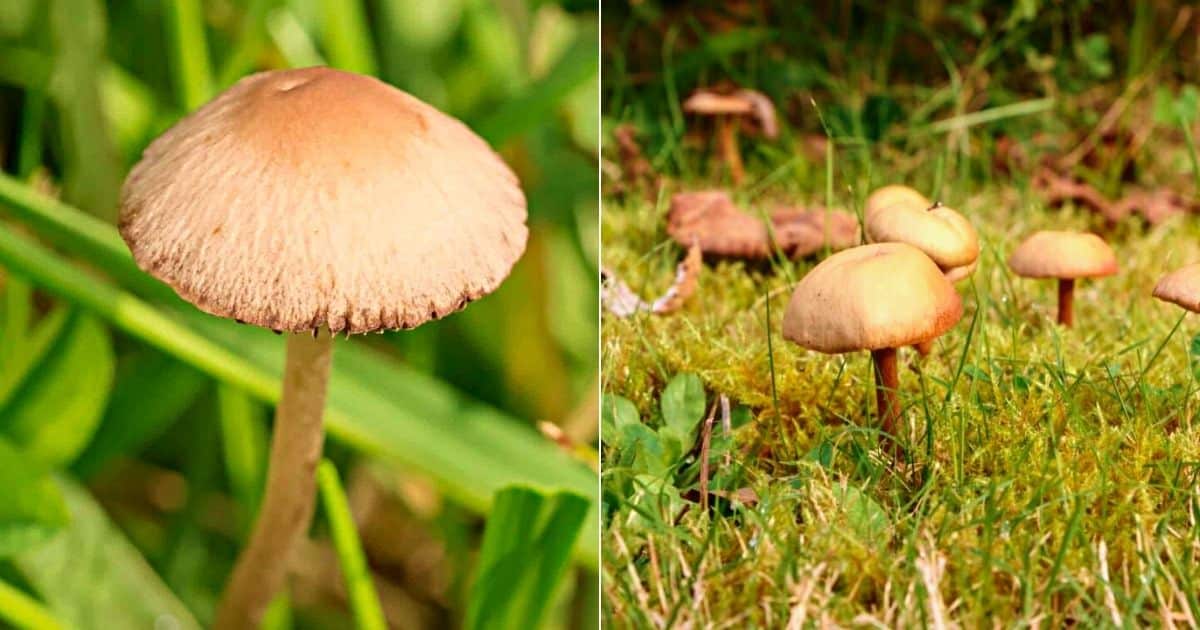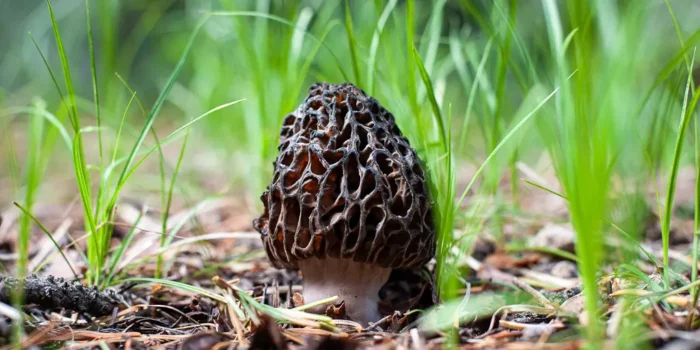Lawnmower Mushroom: Identification, Habitat
The lawnmower mushroom in the lawn(Panaeolus) is a typical and far reaching minimal brown mushroom (LBM) frequently tracked down on lawns and grassy areas.
It is quite possibly of the most boundless yeast in North America and is known to show up on a huge scale, frequently apparently short-term.
Perpetually, small amounts of psilocybin of individuals get exceptionally concerned when they see this yeast spring up on their yards utilized by youngsters and pets.
We’re glad to say it’s anything but a reason for concern, organic material yet it’s great to be familiar with its identification, habitat, possibly perilous clones, and why it shows up on your yard in any case.
Identification
- Cap
The edge of the cap of the lawnmower fungus is generally 1/4-1 1/2 inch in width – it’s a little fungus with a thin stem and a little round cap.
It has a generally widely conical or bell-shaped structure, in the long run becoming curved or almost level.
- Gills
The gills of the lawnmower fungus are barely connected to the stem and can be close or somewhat far off.
They are grayish to caramel from the start, becoming more obscure brown as the fungus develops.
- Stem
The stem is normally 2.5-4 inches long. It is tall, thin, and that’s only the tip of the iceberg or less equivalent or tightens marginally toward the base.
At the point where mushrooms are edible and mushrooms are poisonous in new and youthful form, the stem frequently has finely furrowed vertical lines of a whitish soft or flaky fiber, however it before long becomes uncovered.
- Tissue, Fragrance, and Taste
The tissue is dainty and caramel and doesn’t change tone when cut. This fungus(mushrooms spread) doesn’t have areas of strength for a, however some report a nutty mushroomy smell that lines on disappointing.

Habitat
The lawnmower fungus is saprobic, meaning it benefits from dead or decaying organic matter.
It develops alone or in bunches on yards, meadows, and other verdant regions. It routinely shows up in enormous thick or scattered groupings across the grass.
Mushroom species doesn’t develop on trees, however it might benefit from rotting wood like wood chip mulch.
Frequently, mushrooms in your lawn just accumulates supplements from dead and rotting wood far underneath the dirt. This yeast of mushroom poisoning is broadly disseminated across North America yet is more uncommon in the southeastern states.
How Do I Get Rid Of Lawn Mower Mushrooms?
Common lawn mushrooms are not harmful to yards. They assist with separating tree roots in natural matter and reuse supplements once more into the dirt – this is something to be thankful for.
The presence of these yeast implies you have a yard wealthy in supplements and natural material.
Be that as it may, it is widely distributed to many individuals may not see the value in their appearance on their yards and need to dispose of them.
Destroying lawnmower fungus from your yard is almost unimaginable, as they feed on the natural matter present in the grass.
Rather than attempting to eliminate them, think about embracing their regular job in the environment of your yard. It’ll save you a great deal of migraine!
Assuming not entirely set in stone, you can take a stab at picking them, however, that won’t help a lot.
The mushroom’s “underlying foundations,” known as mycelium, loosen up underground, and to dispose of the mushroom, you’d need to uncover all the mycelium. Essentially, you’d need to obliterate your yard to dispose of the yeast.

What happens when you eat lawnmowers mushroom, panaeolus foenisecii?
Mottlegill, otherwise called the lawnmower’s yeast, is a typical yard yeast that is for the most part thought to be non-harmful.
Consuming this yeast is probably not going to truly hurt, as it isn’t known to be harmful. Notwithstanding, as with any forest yeast, there is a gamble of misidentification.
It’s dependably most secure to try not to eat forest yeast except if you are sure beyond a shadow of a doubt of their character and edibility.
In the event that you have ingested a forest yeast or little brown mushroom and are encountering side effects of harming, like queasiness, regurgitating, looseness of the bowels, or stomach torment, it is essential to promptly look for clinical consideration.

Here are a few central issues about the Lawnmower’s Mushroom (Panaeolus):
- ID: It is a little, earthy colored yeast normally found in verdant regions like yards, subsequently its generally expected name.
It commonly has a ringer formed cap that turns out to be more curved as it develops, with an unmistakable dull focus.
- Edibility: While mottlegill foenisecii is for the most part thought to be non-harmful and not known to be noxious, it isn’t regularly prescribed for utilization because of its boring taste and extreme surface.
Furthermore, there is a gamble of misidentification, which could prompt consuming a harmful mushroom.
- Possible Dangers: Eating wild yeast can be hazardous because of the gamble of misidentification.
A few yeast that seem to be like Panaeolus foenisecii, for example, the stimulating mottlegill cinctulus, can be poisonous and cause unfriendly responses.
- Side effects of Harming: In the event that you have ingested a wild yeast and are encountering side effects like sickness, spewing, the runs, stomach torment, wooziness, or disarray, look for clinical consideration right away.
It is essential to give however much data as could be expected about the mushroom you consumed.
- Counteraction: To stay away from inadvertent ingestion of harmful mushrooms, it is ideal to just consume mushrooms that have been appropriately recognized as safe for utilization by a specialist or mycologist.
If all else fails, trying not to eat wild mushrooms altogether is most secure.
How to Manage Lawn Mushrooms In Your Home Garden
Overseeing yard mushrooms is a drawn out process including progressing support, yet fortunately regardless of how strong they might appear, destroying the mushroom populace from your lawn is conceivable.
You should simply make the grass a less alluring spot for organisms to develop.
However long there are no live mushrooms previously filling in your yard, a basic grass cutting routine can fundamentally lessen development, yet more long haul arrangements will include watching out for the dirt.
Mushrooms regularly flourish in obscure, wet circumstances, so make the inverse in your yard.
Basic changes like restricting shade on the yard to increment sun openness, circulating air through the dirt routinely, and scaling back compost will make the grass an undeniably less cordial climate for mushrooms.
Whenever you have made the ideal setting for lavish yard development, support is critical, and its main part lies in keeping the region clear of mushroom-accommodating materials.
Anything from grass clippings, cover develop, old mulch, overabundance manure, creature waste, and spoiling wood are normal offenders.

7 Common Types of Lawn Mushrooms
- Fairy Ring Mushrooms (Marasmius oreades)
These mushrooms frequently structure a round design in the grass, making the presence of a “Fairy ring.”
They are tan to brown in variety and have a little, umbrella-molded cap.
Fairy ring mushrooms are eatable yet ought to just be scavenged with intense consideration as there are clones which are extremely tricky.
- Inky Caps (Coprinus spp.)
Inky covers are described by their conelike, dark covers that break up into a dark, inky substance as they mature.
They frequently fill in bunches and can be tracked down on rotting wood or in regions with high natural matter.
- Puffballs (Lycoperdon spp.)
Puffballs are round, white mushrooms that can differ in size from marble (little puffballs) to volley ball (monster puffballs).
As they mature, their inside becomes loaded up with spores, which are delivered in a cloud when the puffball is upset.
Puffballs are palatable when they are unadulterated white inside.
- Yard Trimmer’s Mushrooms (Panaeolina foenisecii)
The yard cutter mushrooms are little, brown, and conelike in shape, frequently tracked down in green regions.
They are generally confused with stimulating mushrooms however are really poisonous.
- Milky Conecap (also known as Dullard Covers) (Conocybe apala)
Smooth conecaps are little, sensitive white mushrooms that ordinarily show up on yards.
They have a propensity for showing up first thing in overflow, then drying out and basically vanishing by late evening when the sun is most sizzling.
- Meadow Mushrooms (Agaricus spp.)
It’s likely nothing unexpected that something regularly called the knoll mushroom shows up on yards. This species is consumable, yet has many copies (palatable ones and venomous ones) so ought to be scavenged mindfully.
- Stinkhorns (Phallus spp.)
Stinkhorns have a particular, foul scent and an extraordinary, phallic shape. Or on the other hand, they straight-up seem as though outsiders showed up from another planet!
They are many times tracked down in mulch or rotting wood and can be red, orange, or yellow in variety.
Conclusion
The Lawnmower Mushroom (Panaeolus foenisecii) is a typical grass growth with a chime molded cap and dull brown to dark gills.
Regardless of its honest appearance, it assumes an imperative part in biological system supplement cycling, benefiting from rotting natural matter in yards and lush regions.
While by and large thought to be non-venomous and innocuous assuming ingested in little amounts, it isn’t prescribed for utilization because of its dull taste and extreme surface.
Appropriate ID is vital while scavenging for mushrooms, as misidentification can prompt inadvertent ingestion of harmful species.
By and large, the Lawnmower Mushroom is an entrancing creature that adds to the biodiversity of our current circumstance.






